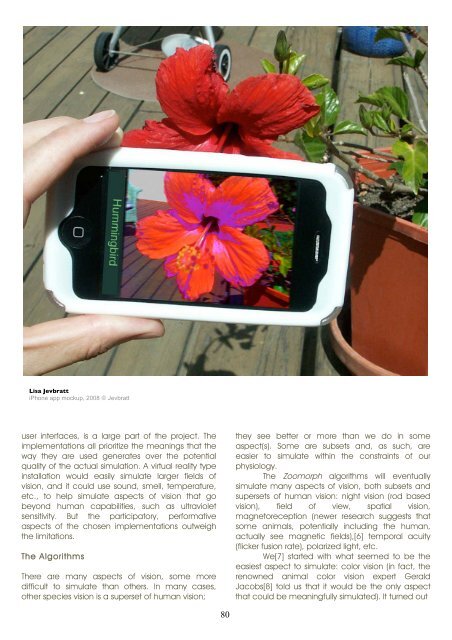Animal Influence I - Antennae The Journal of Nature in Visual Culture
Animal Influence I - Antennae The Journal of Nature in Visual Culture
Animal Influence I - Antennae The Journal of Nature in Visual Culture
Create successful ePaper yourself
Turn your PDF publications into a flip-book with our unique Google optimized e-Paper software.
Lisa Jevbratt<br />
iPhone app mockup, 2008 Jevbratt<br />
user <strong>in</strong>terfaces, is a large part <strong>of</strong> the project. <strong>The</strong><br />
implementations all prioritize the mean<strong>in</strong>gs that the<br />
way they are used generates over the potential<br />
quality <strong>of</strong> the actual simulation. A virtual reality type<br />
<strong>in</strong>stallation would easily simulate larger fields <strong>of</strong><br />
vision, and it could use sound, smell, temperature,<br />
etc., to help simulate aspects <strong>of</strong> vision that go<br />
beyond human capabilities, such as ultraviolet<br />
sensitivity. But the participatory, performative<br />
aspects <strong>of</strong> the chosen implementations outweigh<br />
the limitations.<br />
<strong>The</strong> Algorithms<br />
<strong>The</strong>re are many aspects <strong>of</strong> vision, some more<br />
difficult to simulate than others. In many cases,<br />
other species vision is a superset <strong>of</strong> human vision;<br />
80<br />
they see better or more than we do <strong>in</strong> some<br />
aspect(s). Some are subsets and, as such, are<br />
easier to simulate with<strong>in</strong> the constra<strong>in</strong>ts <strong>of</strong> our<br />
physiology.<br />
<strong>The</strong> Zoomorph algorithms will eventually<br />
simulate many aspects <strong>of</strong> vision, both subsets and<br />
supersets <strong>of</strong> human vision: night vision (rod based<br />
vision), field <strong>of</strong> view, spatial vision,<br />
magnetoreception (newer research suggests that<br />
some animals, potentially <strong>in</strong>clud<strong>in</strong>g the human,<br />
actually see magnetic fields),[6] temporal acuity<br />
(flicker fusion rate), polarized light, etc.<br />
We[7] started with what seemed to be the<br />
easiest aspect to simulate: color vision (<strong>in</strong> fact, the<br />
renowned animal color vision expert Gerald<br />
Jacobs[8] told us that it would be the only aspect<br />
that could be mean<strong>in</strong>gfully simulated). It turned out












